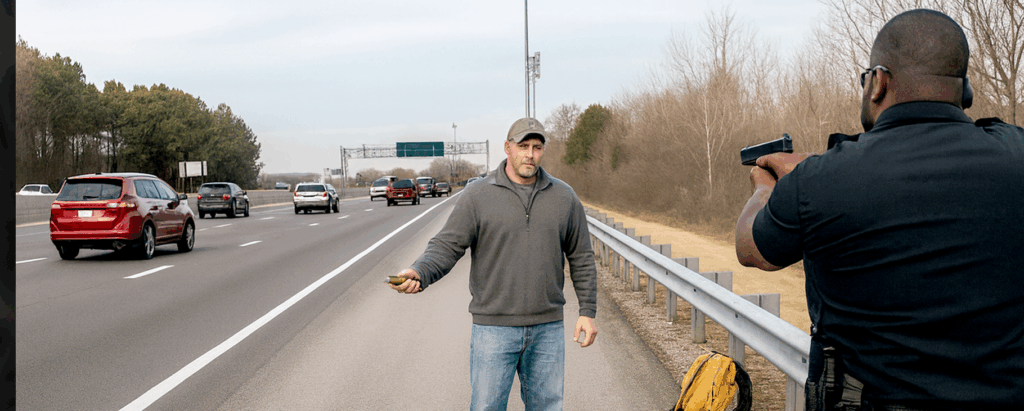Heid v. Rutkoski, 2025 WL 1903800 (11th Cir. 2025)
In Orange County, Florida, Joseph Heid and his wife were at their home, drinking alcohol. Heid’s daughter, stepson and a roommate were also present. After Heid and his wife got into an “ugly” verbal argument, Heid walked to a nearby park for about an hour “to try to cool things.”
Heid eventually returned home, and the argument resumed. When Heid’s wife put her finger in his face, he took the digit into his mouth — not biting down or inflicting pain — in what he described as a “submission hold.” Seeing this, Heid’s stepson whacked Heid in the back of the head. Heid then turned his attention to his stepson, pinning him on the floor and threatening him with physical harm. Heid then once again walked to the nearby park to calm down.
After Heid left, the roommate called 911 and reported Heid and his wife had a physical altercation and Heid tried to hurt his stepson. The roommate called dispatch several minutes later to report the presence of several guns in the house. Deputies Joseph Kramer and Johnerick Sanchez responded to the residence, interviewing the stepson to try to ascertain what happened.
Deputies Sanchez and Kramer went to the park in search of Heid. While they looked, the stepson approached them to report Heid had returned home. Going back to the residence, the deputies placed Heid’s drunk and belligerent wife in a patrol car. At that point, only Heid was still in the house. Deputies Patrick Lewis and Forrest Best arrived at the scene as backup.
Heid’s wife told the deputies her husband was drunk and bit her finger, then choked and threatened to “murder” his stepson. She also advised deputies that several guns, including an AK-47, were inside the house. The stepson reiterated his story about the violent struggle with Heid, also mentioning the guns inside.
Deputy Mark Rutkoski arrived, and Deputy Kramer briefed him on what they knew about the reported events. The deputies established a perimeter, and Deputy Rutkoski used a loudspeaker to identify their presence and command Heid to come out with his hands up. But Heid was not in the house; he was sitting under a tree in the backyard, smoking and trying to calm down. Heid later claimed he did not hear Deputy Rutkowski’s commands.
When Heid heard movement and saw light from Deputy Sanchez’s flashlight, he asked loudly, “Are you going to shoot me?” Sanchez told Heid to remain still and raise his hands, though Heid claimed he didn’t hear those commands, either. Deputy Sanchez radioed, “He’s in the back!” At that point, Heid walked into the house and armed himself with a rifle.
Meanwhile, at the front of the residence, Deputies Rutkoski and Best heard a loud gunshot from behind the house, followed by dozens of gunshots over the next several seconds. According to the deputies, they thought several of the reports — including the first one — sounded like rifle shots. Heid had fired at Deputy Sanchez, prompting a gunfight between Heid and Deputies Sanchez, Lewis and Kramer.
Deputies Rutkoski and Best believed (correctly) Heid was shooting at the deputies in the backyard. Once the gunfire stopped, Deputy Rutkoski asked over the radio whether everyone was all right, but only Deputy Sanchez responded with a “10-4,” indicating he was not injured. When Deputies Kramer and Lewis failed to answer, Deputy Rutkoski feared they were shot and incapacitated. Deputies Rutkoski and Best took cover behind a car.
About 20 seconds later, Deputy Best saw Heid coming out the front door. Heid claimed he shouted, “I’m unarmed. I’m coming out. I’m surrendering. I give up.” Neither Deputy Rutkoski nor Deputy Best heard him make these statements.
Heid moved quickly toward the two deputies. Fearing Heid would start shooting again, Deputy Rutkoski fired 14 times in rapid succession as Heid ran to within three or four feet of him. Deputy Best simultaneously fired five or six times. Heid fell to the ground. He did not have a gun at that point.
Despite being struck by six bullets, Heid recovered. He was tried and convicted of aggravated assault and attempted second degree murder of a law enforcement officer (with a special finding) as well as resisting an officer — both with and without violence.
Heid sued the deputies, alleging excessive force.
The defendant deputies asked the trial court to grant summary judgment based on qualified immunity. The trial court refused, ruling there was a factual dispute about the question of excessive force and whether Heid posed a threat when he ran out of the house. The deputies appealed.
The 11th U.S. Court of Appeals held that Heid failed to show the deputies violated a constitutional right under the Fourth Amendment. The court cited the following undisputed facts:
- Heid, his wife and stepson were involved in domestic violence in which Heid allegedly bit his wife and choked and threatened to kill his stepson.
- There were multiple guns in his home.
- Heid resisted (or at least ignored) the officers in the backyard and engaged them in a gunfight, during which he attempted to murder Deputy Sanchez.
- The deputies in the front heard the gunfight and heard distinctive gunshots indicating Heid was shooting a rifle or shotgun.
- Heid retreated into the house, where there were reportedly more guns.
- Just 27 seconds later, Heid ran out the front door toward the deputies in front.
The appellate court reversed the trial court’s denial of summary judgment, holding it was reasonable for Deputies Rutkoski and Best to believe Heid was armed and dangerous as he came out of the house, even if they did not clearly see a gun in his hands. The court stated the deputies had no way of knowing whether Heid was actually surrendering: “Importantly, Heid’s arms were not over his head with palms open in a classic surrender position.” Citing Graham v. Connor, the court noted, “critically, all of these events happened in a short period of time.”
In his complaint, Heid noted the deputies fired several rounds at him after he fell to the ground. The court recognized it takes time to stop shooting. “Deputies Rutkoski’s and Best’s use of force lasted only three to four seconds in total, until they were fully aware that Heid had fallen to the ground and ceased his movements,” the decision noted. Confirming the findings of a recent 7th Circuit case (that it takes time to start force and also takes time to stop force) the panel declared: “In these tense circumstances, it was not unreasonable for Deputies Rutkoski and Best to very briefly continue using force after Heid fell.”
Because the use of force was reasonable under the circumstances, the court held the deputies were entitled to qualified immunity.



